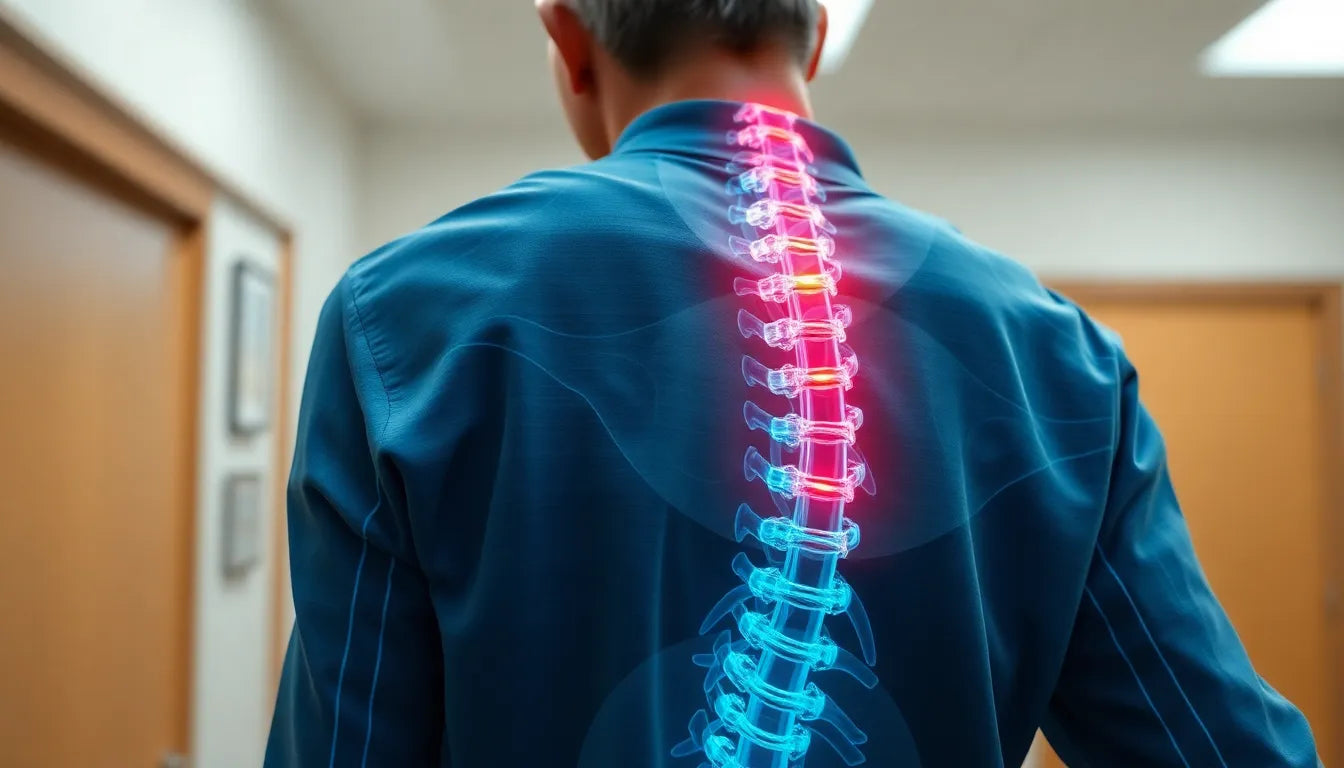Understanding the complexities of disability ratings for herniated discs is crucial for those affected by this condition. A herniated disc occurs when the soft center of a spinal disc pushes through a tear in its tougher exterior, often resulting in pain, numbness, and mobility issues. This condition can significantly impact one's quality of life and ability to work, making the recognition of disability benefits an important consideration for many individuals.
Understanding herniated discs and disability
A herniated disc, also known as a slipped or ruptured disc, can cause a range of symptoms that affect daily activities. The severity of these symptoms varies from person to person, and not every case will qualify for disability benefits. The key factor in determining eligibility is the extent to which the condition impairs an individual's ability to perform work-related tasks. This impairment must be significant enough to prevent the individual from engaging in substantial gainful activity (SGA) for a prolonged period.
Disability recognition for herniated discs is not automatic. It requires a thorough evaluation of medical evidence and a clear demonstration of how the condition limits one's functional capacity. This is where understanding the disability evaluation process, whether through the Social Security Administration (SSA) or the Department of Veterans Affairs (VA), becomes essential.
Purpose of this guide
This guide aims to provide a comprehensive overview of how herniated discs are evaluated for disability benefits. It will explore the criteria used by both the SSA and VA systems, offering insights into the processes involved in obtaining a disability rating. By understanding these systems, individuals can better navigate the complexities of disability claims and increase their chances of receiving the benefits they deserve.
Engaging with the complexities
Are you struggling to work due to a herniated disc and wondering if you qualify for disability benefits? Navigating the intricacies of disability ratings can be daunting, but with accurate medical documentation and a clear understanding of the evaluation criteria, you can make a strong case for your claim. This guide will delve into the specifics of what is required, offering practical advice and insights into both the SSA and VA evaluation processes.
Understanding the nuances of disability ratings for herniated discs is essential for anyone seeking benefits. Whether you're dealing with the SSA's five-step evaluation process or the VA's percentage-based rating system, having the right information and documentation is key. This guide will serve as a valuable resource, providing the knowledge needed to approach the disability claims process with confidence.
Understanding SSA standards for herniated disc disability
The Social Security Administration (SSA) has specific criteria for recognizing herniated discs as potentially disabling conditions. These criteria are outlined in the SSA's Blue Book under Section 1.04, which covers disorders of the spine. For a herniated disc to qualify as a disability, there must be medical evidence showing severe symptoms such as nerve root compression, pain, and functional loss. These symptoms must be significant enough to prevent the individual from engaging in substantial gainful activity (SGA) for at least 12 months.
The SSA uses a five-step sequential evaluation process to determine disability eligibility. This process includes:
- Step 1: Determining if the claimant is currently working. If the individual is engaging in SGA, they may not qualify for benefits.
- Step 2: Assessing the severity of the condition. The herniated disc must significantly limit the person's ability to perform basic work activities.
- Step 3: Checking if the condition meets or equals a listing in the Blue Book. If it does, the individual may be considered disabled.
- Step 4: Evaluating the ability to perform past work. If the individual can still perform their previous job, they may not qualify for benefits.
- Step 5: Assessing the ability to do any other work. If the person cannot perform any other type of work, they may be considered disabled.
VA disability ratings for herniated discs
The Department of Veterans Affairs (VA) uses a percentage-based system to rate disabilities related to herniated discs. This system ranges from 10% to 60%, depending on the severity of the condition. The VA considers factors such as the frequency and duration of incapacitating episodes and limitations in the range of motion when assigning a rating.
The VA Schedule 38 CFR § 4.71a provides guidelines for determining these ratings. Here’s a breakdown of the rating percentages:
- 10%: Assigned for minor, short incapacity episodes.
- 20%–60%: Assigned for longer or more frequent incapacitating episodes, with the higher percentages reflecting severe ongoing impairment.
These ratings are crucial for veterans seeking disability benefits, as they determine the level of compensation and support available. The VA's approach focuses on both physical examination findings and the functional impact of the condition on daily life.
Comparing SSA and VA disability systems
While both the SSA and VA systems evaluate herniated discs for disability benefits, there are notable differences in their approaches. The SSA's process is more focused on the ability to work and the duration of impairment, whereas the VA uses a percentage-based system that considers the severity of symptoms and their impact on a veteran's life.
For veterans, it is possible to qualify for disability benefits under both systems. Understanding the criteria and processes of each can help individuals navigate their claims more effectively. By providing comprehensive medical documentation and demonstrating the impact of the herniated disc on daily activities, claimants can strengthen their case for receiving benefits.
In summary, navigating the disability ratings for herniated discs requires a thorough understanding of both SSA and VA standards. By meeting the specific criteria set forth by these organizations and compiling detailed medical evidence, individuals can improve their chances of obtaining the disability benefits they need to manage their condition effectively.
Practical guidance for claimants
Successfully navigating disability ratings for herniated discs requires meticulous preparation and documentation. The importance of comprehensive medical records cannot be overstated. These records should detail the symptoms, treatments, and the impact of the condition on daily life. Claimants should actively engage in compiling evidence to support their disability claims.
Here are some tips for gathering the necessary documentation:
- Maintain a symptom diary: Regularly record the severity and frequency of symptoms, including pain levels, mobility issues, and any episodes of incapacitation.
- Obtain thorough medical evaluations: Seek detailed reports from healthcare providers that outline the diagnosis, treatment plans, and prognosis.
- Gather statements from healthcare providers: Request written statements that describe how the herniated disc limits your ability to work and perform daily activities.
Real-life examples and case studies
To illustrate successful claims, consider hypothetical scenarios where claimants have effectively demonstrated their eligibility for disability benefits. For instance, a claimant who meticulously documented their symptoms and provided comprehensive medical reports might successfully navigate the SSA's five-step evaluation process. By presenting clear evidence of nerve root compression and functional loss that prevents substantial gainful activity, they could secure benefits.
Conversely, common pitfalls in the claims process often include insufficient documentation or failure to demonstrate the condition's impact on work capacity. Avoid these by ensuring all medical records are up-to-date and by clearly articulating how the herniated disc affects your daily life.
Frequently asked questions
What symptoms of a herniated disc are considered disabling?
Symptoms such as severe pain, numbness, weakness, and loss of function that significantly impede the ability to work are considered disabling.
How long does the disability claim process take for a herniated disc?
The duration varies, but the SSA process generally takes several months to over a year, depending on the complexity of the case and the backlog of claims.
Can I apply for both SSA and VA disability benefits?
Yes, you can apply for both SSA and VA disability benefits if you meet the eligibility criteria for each system. Veterans may qualify under both systems, potentially increasing their support.
What should I do if my disability claim is denied?
If your claim is denied, consider appealing the decision. It is advisable to seek legal advice to strengthen your case and ensure all necessary documentation is presented.
Are there any resources to help with the application process?
Yes, there are numerous resources available, including legal aid organizations, disability advocates, and online platforms that provide guidance and support throughout the application process.
In conclusion, navigating the disability ratings for herniated discs involves understanding both SSA and VA systems, compiling comprehensive medical documentation, and clearly demonstrating the impact of the condition on daily life. By following the guidance provided and utilizing available resources, claimants can enhance their chances of securing the benefits they need.
Sources
- Atticus. "Eligibility Focus: Herniated Disc Disability."
- Citizens Disability. "Step-by-Step Guidance for Herniated Disc Disability."
- My Philadelphia Disability Lawyer. "Dual Focus on SSA and VA Disability Standards."
- DiscSeel. "VA-Specific Breakdown of Herniated Disc Ratings."
- Barricaid Blog. "Educational Guide to SSA’s Five-Step Process."
- Mayo Clinic. "Herniated Disk: Symptoms and Causes."
- NCBI. "Medical Context of Herniated Discs."


















